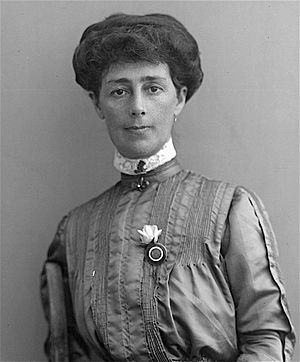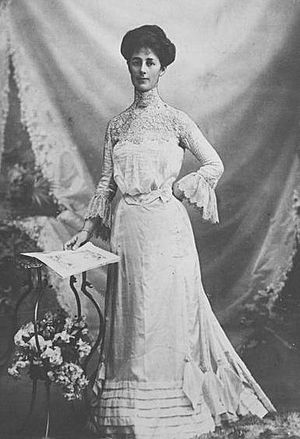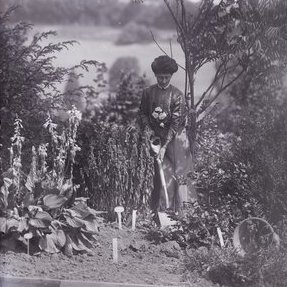Vida Goldstein facts for kids
Quick facts for kids
Vida Goldstein
|
|
|---|---|
 |
|
| Born | 13 April 1869 Portland, Victoria, Australia
|
| Died | 15 August 1949 (aged 80) South Yarra, Victoria, Australia
|
| Nationality | Australian |
| Education | Presbyterian Ladies' College, Melbourne |
| Occupation | Suffragette Social reformer Magazine editor |
| Known for | One of the first four Australian women to stand for parliament |
Vida Jane Mary Goldstein (born 13 April 1869 – died 15 August 1949) was an Australian woman who worked hard for women's rights. She was a suffragette, meaning she fought for women to have the right to vote. She was also a social reformer, working to make society fairer for everyone.
Vida Goldstein was one of the first four women in Australia to try and become a member of parliament. This happened in the 1903 federal election, which was the first time women were allowed to run for office.
She was born in Portland, Victoria. Her family moved to Melbourne when she was about eight years old. There, she went to Presbyterian Ladies' College, Melbourne. Vida followed her mother into the movement for women's voting rights. Soon, she became a leader. She was known for her great public speaking and for editing magazines that supported women's suffrage. Even with her efforts, Victoria was the last Australian state to give women the right to vote, which finally happened in 1908.
In 1903, Vida tried to get elected to the Australian Senate. She ran as an independent candidate, meaning she didn't belong to a major political party. She didn't win, but she got a lot of votes. She was one of the first four women to run for federal parliament. The others were Selina Anderson, Nellie Martel, and Mary Moore-Bentley. Vida ran for parliament four more times. She never won, but she almost always got enough votes to get her election deposit back. She supported ideas that were quite new and progressive for her time. Some of her strong views made it hard for her to get support from everyone.
After women got the right to vote, Vida kept working for women's rights and other social changes. She was a strong pacifist during World War I, meaning she was against war. She helped start the Women's Peace Army, a group that worked for peace. Later in life, Vida became less involved in public life. She spent most of her time with the Christian Science movement. When she died, not many people noticed at first. But later, people began to understand how much she had done for Australia.
Contents
Vida Goldstein's Early Life
Vida Jane Mary Goldstein was born in Portland, Victoria. She was the oldest child of Jacob Goldstein and Isabella Hawkins. Her father was an officer in the army. Her mother was also a suffragist, working for women's voting rights. She also worked to improve society. Both of Vida's parents were very religious and cared deeply about helping others. Vida had four younger siblings: Lina, Elsie, Aileen, and Selwyn.
The Goldstein family moved to Melbourne in 1877. Vida's father became very involved in charity work. He helped many different social groups. Even though her father didn't support women voting, he believed strongly in education. He made sure his four daughters were well-educated. Vida went to Presbyterian Ladies' College, Melbourne in 1884.
In the 1890s, the family's money became tight. So, Vida and her sisters, Aileen and Elsie, started a school. It was called 'Ingleton' and taught both boys and girls. The school ran from their family home in St Kilda, Victoria for six years, starting in 1892.
Fighting for Women's Rights
In 1891, when Vida was 22, her mother asked her to help collect signatures for a petition. This petition asked for women to have the right to vote. For a few years, Vida stayed on the edge of the women's movement. She was more interested in her school and helping people in cities. She saw how women were treated unfairly in society and at work. She soon believed this was because they didn't have political power.
Through her work, she became friends with Annette Bear-Crawford. They worked together on social issues, including women's right to vote. After Annette died in 1899, Vida took on a bigger role. She became the secretary for the United Council for Woman Suffrage. Vida became a very popular public speaker. She gave speeches to large crowds all over Australia, and even in Europe and the United States.
In 1902, she traveled to the United States. She spoke at an international conference for women's voting rights. She also spoke to a committee in the United States Congress, telling them why women should vote.
In 1903, Vida ran for the Australian Senate. She was an independent candidate, supported by a new group called the Women's Federal Political Association. She became one of the first women in the British Empire to run for a national parliament. Australian women had won the right to vote in federal elections in 1902. Vida received many votes but did not win a Senate seat.
After losing the election, she focused on educating women about politics. She did this through the Women's Political Association (WPA). She also started a monthly magazine called Australian Women's Sphere. She said it was a way for women who supported the cause to communicate. She ran for parliament again in 1910, 1913, and 1914. Her last attempt was in 1917, where she ran for a Senate seat based on international peace. This idea was not popular and she lost votes. She always campaigned on her own ideas, which were often very progressive. This made it hard for her to get a lot of support.
Other Important Work
From the 1890s to the 1920s, Vida Goldstein actively supported women's rights. She worked with many groups, like the National Council of Women. She spoke to parliament about important issues. These included equal property rights for women and equal laws for becoming a citizen. She also pushed for children's courts and raising the age when people could get married. Her writings in newspapers and magazines were very important in Australia's social life during the early 1900s.
In 1909, she started a second newspaper called Woman Voter. She had closed her first paper in 1905 to focus on getting women the vote in Victoria. Woman Voter helped support her later political campaigns. Vida was one of the few Australian women fighting for suffrage who became famous around the world.
In early 1911, Vida visited England. She was invited by the Women's Social and Political Union. Her speeches there drew huge crowds. Her tour was called "the biggest thing that has happened in the women movement for some time in England." She also visited Eagle House near Bath. This house was a safe place for British suffragettes who had been released from prison. The family who owned the house planted trees to remember the achievements of suffragettes. Vida was invited to plant a holly tree there.
Her trip to England ended with the creation of the Australia and New Zealand Women Voters Association. This group worked to make sure the British Parliament did not harm the voting rights laws in Australia and New Zealand.
During the First World War, Vida was a strong pacifist. She became the head of the Peace Alliance. In 1915, she started the Women's Peace Army. In 1919, she went to a Women's Peace Conference in Switzerland. She was away for three years. During this time, her public work with Australian feminism slowly ended. Her political group closed, and her newspapers stopped printing. She still believed strongly that women had special and important contributions to make to society. Later in her life, her writings showed more support for socialist ideas.
Later Life and Legacy
In her last years, Vida focused more on her faith. She believed spirituality could solve the world's problems. She became very involved with the Christian Science movement. She helped start their church in Melbourne. For the next twenty years, she worked as a reader and healer for the church.
Vida never married. She lived her last years with her two sisters, Aileen and Elsie. Vida Goldstein died from cancer at her home in South Yarra, Victoria on 15 August 1949. She was 80 years old.
At the time, her death was not widely noticed. But later, Vida Goldstein became known as a pioneer for women's voting rights. She is now seen as an important person in Australian history. She has inspired many women who came after her.
In 1978, a street in Canberra was named Goldstein Crescent in her honor. In 1984, an election area in Melbourne was named the Division of Goldstein after her. Seats in her honor have been placed in Parliament House Gardens, Melbourne, and in Portland, Victoria. The Women's Electoral Lobby in Victoria has also named an award after her. In 2008, which was 100 years since women could vote in Victoria, Vida's contributions were remembered.
See also
 In Spanish: Vida Goldstein para niños
In Spanish: Vida Goldstein para niños



